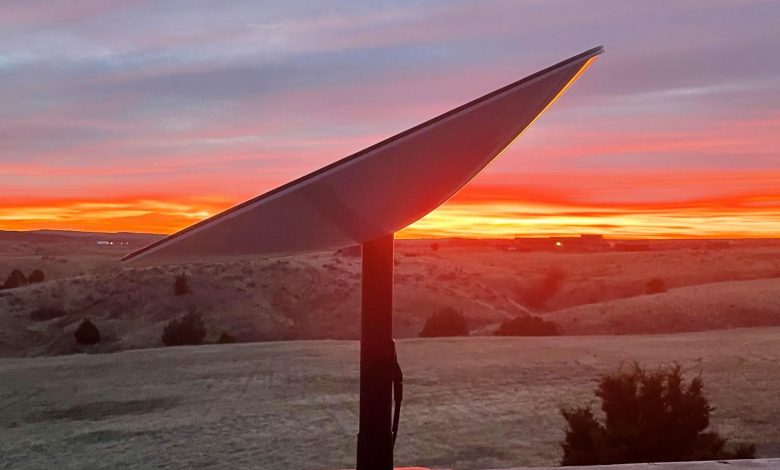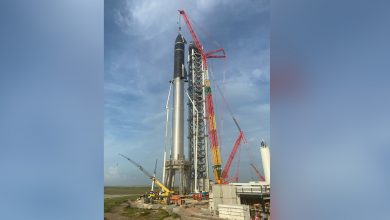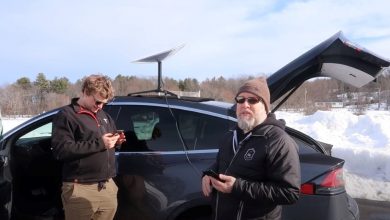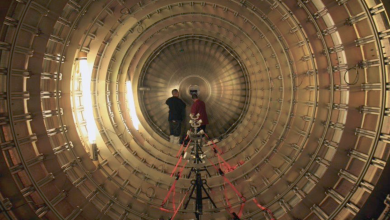
With the summer mercury rising, users of Space Exploration Technologies Corp.’s (SpaceX) Starlink satellite-based internet constellation are also facing the heat. Users in Nevada and Arizona are reporting temperatures as high as 122°F and witnessing their satellite dishes shutting down as a result. Starlink representatives have also confirmed that the dishes cannot operate at 122°F, which makes us ponder whether a new dish currently waiting for the Federal Communications Commission’s (FCC) approval is a solution to these problems due to its lower transmit power.
Unfortunately, a Starlink beta user in Arizona said he lost Internet service for over seven hours yesterday when the satellite dish overheated, demonstrating one of the drawbacks of SpaceX’s broadband service. When the user’s Internet service was disrupted, the Starlink app provided an error message saying, “Offline: Thermal shutdown.” The dish “overheated” and “Starlink will reconnect after cooling down,” the error message said.
The user, named Martin, posted a screenshot of the error message on Reddit. He contacted Starlink support, which told him, “Dishy will go into thermal shutdown at 122F and will restart when it reaches 104F.” Martin decided to give the dish a little water so it could cool down. He pointed a sprinkler at Dishy, and once it cooled enough to turn back on, “I immediately heard YouTube resume playback,” he wrote yesterday.
But the Internet restoration was short-lived, Martin told Ars in a chat today.
“The fix was temporary,” he told us. “When I stopped the sprinkler, [the dish] heated back up and would cycle back on for a few minutes and go back down for thermal shutdown. The overheating started that day about 11:30 am and came back for good about 7 pm… I’m currently headed to a hardware store to get materials to build a solar shade/sail around the dish to see if it doesn’t impact connection and speed.”
Martin uses the ground behind his house to set up his dish because it is the only spot with no obstructions. But there’s “no shade to speak of,” he wrote in the Reddit comment thread.
Starlink Dish Falters At 122°F But Holds Its Ground At Slightly Lower 111°F
Courtesy of two reports on the social media platform Reddit, we can gauge just how ‘hot’ a Starlink dish can get. Details shared by SpaceX engineers last year revealed that the user terminal is capable of operating in temperatures as low as -30°C (-22°F) and as high as 40°C (104°F) and that the company has tested it at 45°C (113°F).
The tests seem to have held up in real life as Reddit user matsayz1’s terminal performed flawlessly even as the temperature soared to 111°F in Las Vegas, Nevada yesterday. Sharing temperature and dish usage statistics, the user revealed that his terminal did not either turn off or experience any service outages. This demonstrated that the dish is capable of performing beyond what SpaceX’s representatives outlined last year.
However, the story was different for user Society Tomorrow, who lives in Arizona. This user’s dish turned off when the temperature hit an eye-popping 122°F in his area, and the occurrence was normal according to the SpaceX representatives who were contacted later.
Both these instances suggest that perhaps the new user terminals currently pending authorization at the FCC are designed to work in hotter areas. Their specifications shared by SpaceX with the Commission reveal that instead of the current dish’s transmitting power of 4.03, the new terminals will transmit at 2.44 Watts. Transmit power is a key influencer of a dish’s temperature, and when combined with the high temperatures in Arizona, it stands to raise overall temperatures to an unsustainable level.
Since SocietyTomorrow’s dish turning off due to extreme heat is the first report of its kind, it’s uncertain whether rising temperatures in several American states will cause Starlink and SpaceX a major headache. Even though the internet service is in its beta stage, user expectations are high, but the beta users are also equally forgiving for outages, and as we’ve seen, for the overheated dish.

Thermal shutdowns affect other users
Officially, SpaceX has said that “Dishy McFlatface” is certified to operate from 22° below zero up to 104° Fahrenheit. Temperatures reached about 120° yesterday in Martin’s town of Topock, near Arizona’s border with California, he said. Though Dishy doesn’t go into thermal shutdown until it hits 122°, the dish can obviously get hotter than the air temperature.
“I’m thinking the radiating heat from the ground is effectively cooking the bottom of the dish, [while] the top of the dish is cooked by the sun,” Martin told Ars. In addition to the shade he’s building, Martin said he is “waiting for permitting for a HAM radio tower” that would lift the dish off the ground to help keep it cool enough to operate.
Martin said he also had very short outages on several days since last week, but service came back before he had time to confirm whether they were caused by heat. SpaceX told users to expect periodic outages during beta, so Martin’s previous outages could have been due either to heat or satellite availability.
Another user in Virginia experienced a half-hour outage due to overheating on a day with temperatures in the low 80s, according to a Reddit post two months ago.
Martin’s post spurred a response from a beta user who also reported thermal shutdowns. “You’re not the only one. My Starlink is located 50 miles south of Grand Canyon in remote area,” one person wrote yesterday. “It’s been off and on also. It stopped today one hour after cool down period but quit again as [of] ~12:30. Last reported temp at my weather station was 103 degrees.”
The 122° F shutdown temperature was mentioned three weeks ago in a Reddit post by a user who had also been given the figure by Starlink support. “‘That’s it??’ was my thought. On a 90 degree day, the rooftop of my house can be around 125 degrees,” that user wrote.
“Are you sure that wasn’t Celsius?” another asked. (122° C converts to 251.6° F.)
If these outages become more common, perhaps SpaceX might ship the second-generation Starlink user dishes to hotter states. Additionally, the company could also provide users with the option to chose between dishes once the newer terminals are available in the market and Starlink rolls out to a wider range of users. While a higher transmit power increases a dish’s range, the newer terminals’ improved efficiency and power densities. Additionally, they will also communicate with the orbiting satellites for a longer duration, indicating that perhaps SpaceX is aware of the lower range’s performance sacrifices.
SpaceX seeks stability before exiting beta
The Starlink public beta began in October 2020, and there’s still no word on when exactly it will hit commercial availability. But the service could happen within months, as SpaceX CEO Elon Musk has said that Starlink will be available to “most of Earth” by the end of 2021 and the whole planet by next year. Still, SpaceX expects to have a limited number of slots in each geographic region because of capacity constraints.
SpaceX is seeking Federal Communications Commission permission to deploy up to 5 million user terminals in the US. Over 500,000 people have ordered Starlink, and Musk has said he expects all of those users to get service. But he also said that SpaceX will face “more of a challenge when we get into the several million user range.” The biggest limitation would be in densely populated urban areas; rural users would have better odds of getting service.
As noted earlier, Starlink warns beta users to expect “brief periods of no connectivity at all”—even if they don’t run into thermal shutdowns. “We still have a lot of work to do to make the network reliable,” SpaceX president and COO Gwynne Shotwell said in April. “We still have drops, not necessarily just because of where the satellites are in the sky.” SpaceX will keep the service in beta “until the network is reliable and great and something we’d be proud of,” Shotwell said.
The Verge reviewed Starlink last month and found frustrating reliability problems. “Like the similarly over-hyped mmWave 5G, Starlink is remarkably delicate. Even a single tree blocking the dish’s line of sight to the horizon will degrade and interrupt your Starlink signal,” The Verge wrote.
Starlink is only part of the solution
The service will surely become more stable by the time SpaceX moves it from beta to general availability, as Shotwell promised. Even in beta, Starlink is providing much-needed connectivity to people with no other options. If SpaceX brings reliable broadband to a few million users, that would be a success, but there may be tens of millions of Americans without access to high-speed broadband. Tens of millions of others have to pay whatever the cable company demands because there’s no competition where they live.
Widespread fiber-to-the-home deployment would make a bigger difference for more Internet users than Starlink. President Joe Biden pledged to lower prices and deploy “future-proof” broadband to all Americans, but he’s already scaled back his plan in the face of opposition from Republicans and incumbent ISPs. AT&T has been lobbying against nationwide fiber and funding for municipal networks, and AT&T CEO John Stankey expressed confidence last week that Congress will steer legislation in the direction that AT&T favors.





